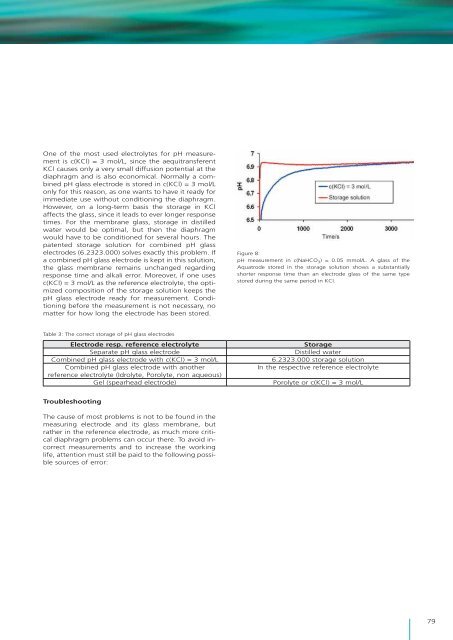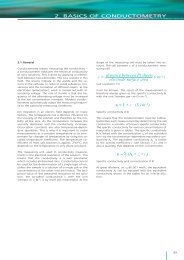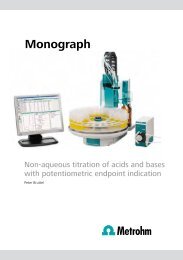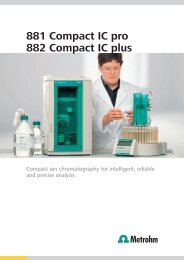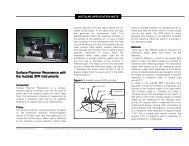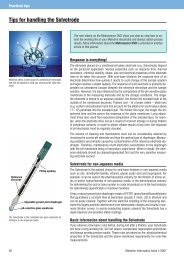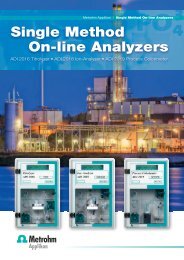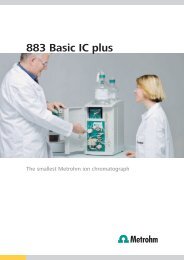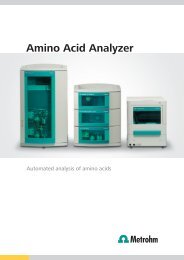What is the theoretical background of potentiometry? - Metrohm
What is the theoretical background of potentiometry? - Metrohm
What is the theoretical background of potentiometry? - Metrohm
Create successful ePaper yourself
Turn your PDF publications into a flip-book with our unique Google optimized e-Paper software.
One <strong>of</strong> <strong>the</strong> most used electrolytes for pH measurement<strong>is</strong> c(KCl) = 3 mol/L, since <strong>the</strong> aequitransferentKCl causes only a very small diffusion potential at <strong>the</strong>diaphragm and <strong>is</strong> also economical. Normally a combinedpH glass electrode <strong>is</strong> stored in c(KCl) = 3 mol/Lonly for th<strong>is</strong> reason, as one wants to have it ready forimmediate use without conditioning <strong>the</strong> diaphragm.However, on a long-term bas<strong>is</strong> <strong>the</strong> storage in KClaffects <strong>the</strong> glass, since it leads to ever longer responsetimes. For <strong>the</strong> membrane glass, storage in d<strong>is</strong>tilledwater would be optimal, but <strong>the</strong>n <strong>the</strong> diaphragmwould have to be conditioned for several hours. Thepatented storage solution for combined pH glasselectrodes (6.2323.000) solves exactly th<strong>is</strong> problem. Ifa combined pH glass electrode <strong>is</strong> kept in th<strong>is</strong> solution,<strong>the</strong> glass membrane remains unchanged regardingresponse time and alkali error. Moreover, if one usesc(KCl) = 3 mol/L as <strong>the</strong> reference electrolyte, <strong>the</strong> optimizedcomposition <strong>of</strong> <strong>the</strong> storage solution keeps <strong>the</strong>pH glass electrode ready for measurement. Conditioningbefore <strong>the</strong> measurement <strong>is</strong> not necessary, nomatter for how long <strong>the</strong> electrode has been stored.Figure 8:pH measurement in c(NaHCO 3 ) = 0.05 mmol/L. A glass <strong>of</strong> <strong>the</strong>Aquatrode stored in <strong>the</strong> storage solution shows a substantiallyshorter response time than an electrode glass <strong>of</strong> <strong>the</strong> same typestored during <strong>the</strong> same period in KCl.Table 3: The correct storage <strong>of</strong> pH glass electrodesElectrode resp. reference electrolyteSeparate pH glass electrodeCombined pH glass electrode with c(KCl) = 3 mol/LCombined pH glass electrode with ano<strong>the</strong>rreference electrolyte (Idrolyte, Porolyte, non aqueous)Gel (spearhead electrode)StorageD<strong>is</strong>tilled water6.2323.000 storage solutionIn <strong>the</strong> respective reference electrolytePorolyte or c(KCl) = 3 mol/LTroubleshootingThe cause <strong>of</strong> most problems <strong>is</strong> not to be found in <strong>the</strong>measuring electrode and its glass membrane, butra<strong>the</strong>r in <strong>the</strong> reference electrode, as much more criticaldiaphragm problems can occur <strong>the</strong>re. To avoid incorrectmeasurements and to increase <strong>the</strong> workinglife, attention must still be paid to <strong>the</strong> following possiblesources <strong>of</strong> error:79


